Medicine Consumption in Australia: PBS Scheme and Cost Analysis
VerifiedAdded on 2023/06/12
|15
|2348
|304
Report
AI Summary
This report delves into the consumption of medicines in Australia, highlighting the role and challenges of the Pharmaceutical Benefits Scheme (PBS) in controlling costs and ensuring access to essential medications. It discusses the reasons behind the high cost of medicines in Australia, including the pricing mechanisms, the influence of pharmaceutical companies, and taxation policies. The report also examines the types of medicines most commonly consumed, such as antidepressants, cholesterol-lowering drugs, and antibiotics, and explores the factors driving their increased use, such as obesity and depression. Furthermore, it categorizes drug use into prescribed and non-prescribed medications, providing data on the most frequently used drugs and their utilization trends. The report concludes by addressing the issues with the PBS, such as its medicine reviewing process and the involvement of industrialists in price determination, and emphasizes the need for a more equitable and efficient system to ensure affordable access to medicines for all Australians. Desklib provides a platform for students to access this and other solved assignments.
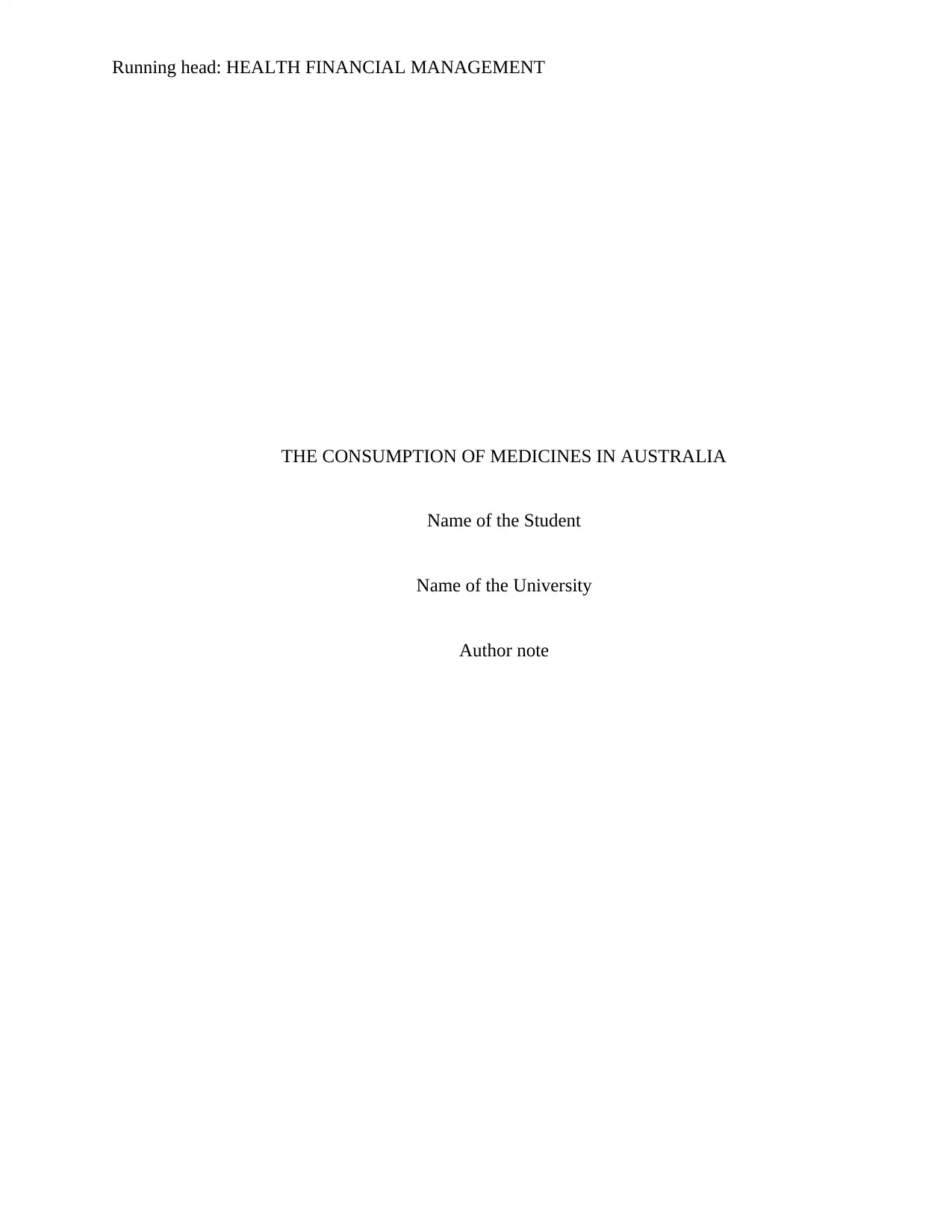
Running head: HEALTH FINANCIAL MANAGEMENT
THE CONSUMPTION OF MEDICINES IN AUSTRALIA
Name of the Student
Name of the University
Author note
THE CONSUMPTION OF MEDICINES IN AUSTRALIA
Name of the Student
Name of the University
Author note
Paraphrase This Document
Need a fresh take? Get an instant paraphrase of this document with our AI Paraphraser
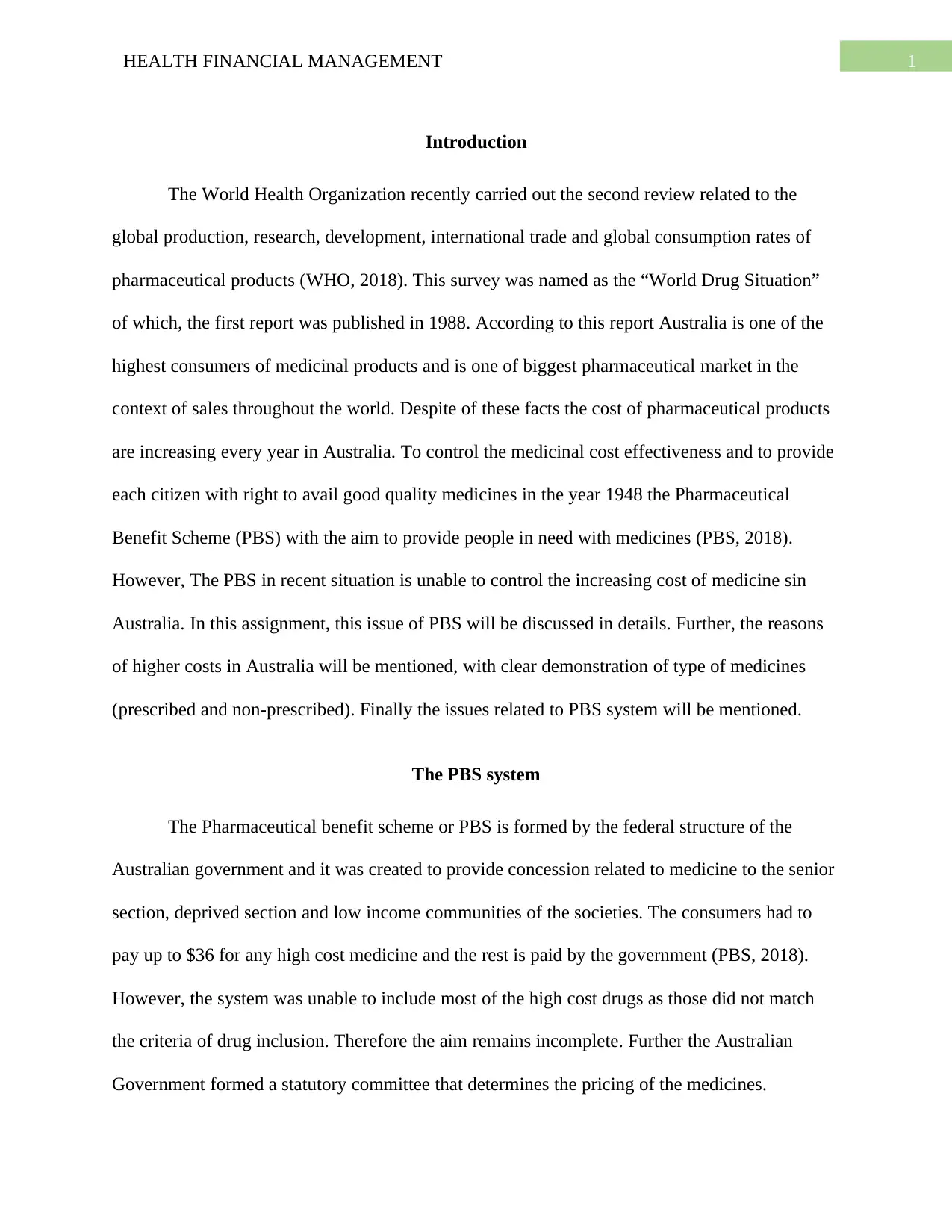
1HEALTH FINANCIAL MANAGEMENT
Introduction
The World Health Organization recently carried out the second review related to the
global production, research, development, international trade and global consumption rates of
pharmaceutical products (WHO, 2018). This survey was named as the “World Drug Situation”
of which, the first report was published in 1988. According to this report Australia is one of the
highest consumers of medicinal products and is one of biggest pharmaceutical market in the
context of sales throughout the world. Despite of these facts the cost of pharmaceutical products
are increasing every year in Australia. To control the medicinal cost effectiveness and to provide
each citizen with right to avail good quality medicines in the year 1948 the Pharmaceutical
Benefit Scheme (PBS) with the aim to provide people in need with medicines (PBS, 2018).
However, The PBS in recent situation is unable to control the increasing cost of medicine sin
Australia. In this assignment, this issue of PBS will be discussed in details. Further, the reasons
of higher costs in Australia will be mentioned, with clear demonstration of type of medicines
(prescribed and non-prescribed). Finally the issues related to PBS system will be mentioned.
The PBS system
The Pharmaceutical benefit scheme or PBS is formed by the federal structure of the
Australian government and it was created to provide concession related to medicine to the senior
section, deprived section and low income communities of the societies. The consumers had to
pay up to $36 for any high cost medicine and the rest is paid by the government (PBS, 2018).
However, the system was unable to include most of the high cost drugs as those did not match
the criteria of drug inclusion. Therefore the aim remains incomplete. Further the Australian
Government formed a statutory committee that determines the pricing of the medicines.
Introduction
The World Health Organization recently carried out the second review related to the
global production, research, development, international trade and global consumption rates of
pharmaceutical products (WHO, 2018). This survey was named as the “World Drug Situation”
of which, the first report was published in 1988. According to this report Australia is one of the
highest consumers of medicinal products and is one of biggest pharmaceutical market in the
context of sales throughout the world. Despite of these facts the cost of pharmaceutical products
are increasing every year in Australia. To control the medicinal cost effectiveness and to provide
each citizen with right to avail good quality medicines in the year 1948 the Pharmaceutical
Benefit Scheme (PBS) with the aim to provide people in need with medicines (PBS, 2018).
However, The PBS in recent situation is unable to control the increasing cost of medicine sin
Australia. In this assignment, this issue of PBS will be discussed in details. Further, the reasons
of higher costs in Australia will be mentioned, with clear demonstration of type of medicines
(prescribed and non-prescribed). Finally the issues related to PBS system will be mentioned.
The PBS system
The Pharmaceutical benefit scheme or PBS is formed by the federal structure of the
Australian government and it was created to provide concession related to medicine to the senior
section, deprived section and low income communities of the societies. The consumers had to
pay up to $36 for any high cost medicine and the rest is paid by the government (PBS, 2018).
However, the system was unable to include most of the high cost drugs as those did not match
the criteria of drug inclusion. Therefore the aim remains incomplete. Further the Australian
Government formed a statutory committee that determines the pricing of the medicines.
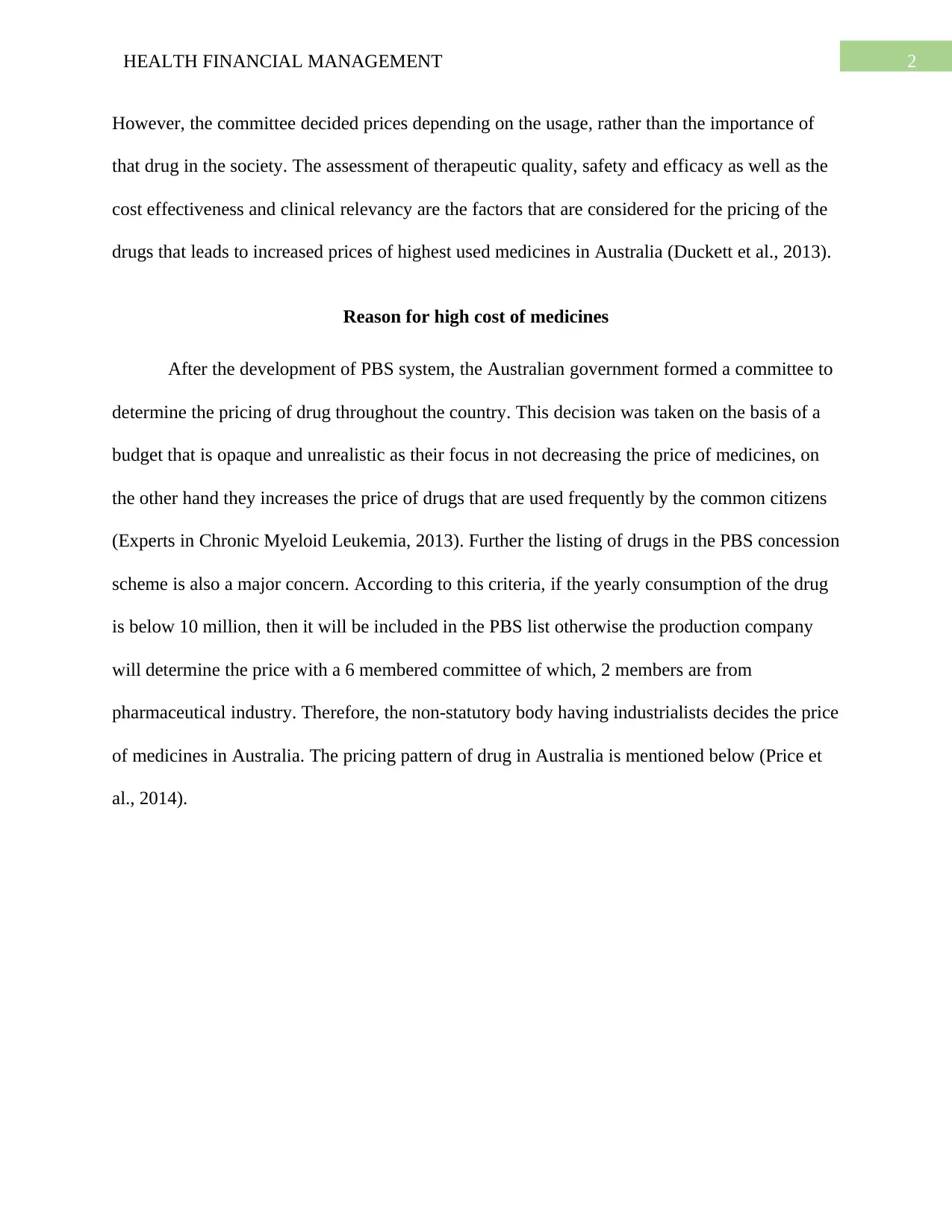
2HEALTH FINANCIAL MANAGEMENT
However, the committee decided prices depending on the usage, rather than the importance of
that drug in the society. The assessment of therapeutic quality, safety and efficacy as well as the
cost effectiveness and clinical relevancy are the factors that are considered for the pricing of the
drugs that leads to increased prices of highest used medicines in Australia (Duckett et al., 2013).
Reason for high cost of medicines
After the development of PBS system, the Australian government formed a committee to
determine the pricing of drug throughout the country. This decision was taken on the basis of a
budget that is opaque and unrealistic as their focus in not decreasing the price of medicines, on
the other hand they increases the price of drugs that are used frequently by the common citizens
(Experts in Chronic Myeloid Leukemia, 2013). Further the listing of drugs in the PBS concession
scheme is also a major concern. According to this criteria, if the yearly consumption of the drug
is below 10 million, then it will be included in the PBS list otherwise the production company
will determine the price with a 6 membered committee of which, 2 members are from
pharmaceutical industry. Therefore, the non-statutory body having industrialists decides the price
of medicines in Australia. The pricing pattern of drug in Australia is mentioned below (Price et
al., 2014).
However, the committee decided prices depending on the usage, rather than the importance of
that drug in the society. The assessment of therapeutic quality, safety and efficacy as well as the
cost effectiveness and clinical relevancy are the factors that are considered for the pricing of the
drugs that leads to increased prices of highest used medicines in Australia (Duckett et al., 2013).
Reason for high cost of medicines
After the development of PBS system, the Australian government formed a committee to
determine the pricing of drug throughout the country. This decision was taken on the basis of a
budget that is opaque and unrealistic as their focus in not decreasing the price of medicines, on
the other hand they increases the price of drugs that are used frequently by the common citizens
(Experts in Chronic Myeloid Leukemia, 2013). Further the listing of drugs in the PBS concession
scheme is also a major concern. According to this criteria, if the yearly consumption of the drug
is below 10 million, then it will be included in the PBS list otherwise the production company
will determine the price with a 6 membered committee of which, 2 members are from
pharmaceutical industry. Therefore, the non-statutory body having industrialists decides the price
of medicines in Australia. The pricing pattern of drug in Australia is mentioned below (Price et
al., 2014).
⊘ This is a preview!⊘
Do you want full access?
Subscribe today to unlock all pages.

Trusted by 1+ million students worldwide
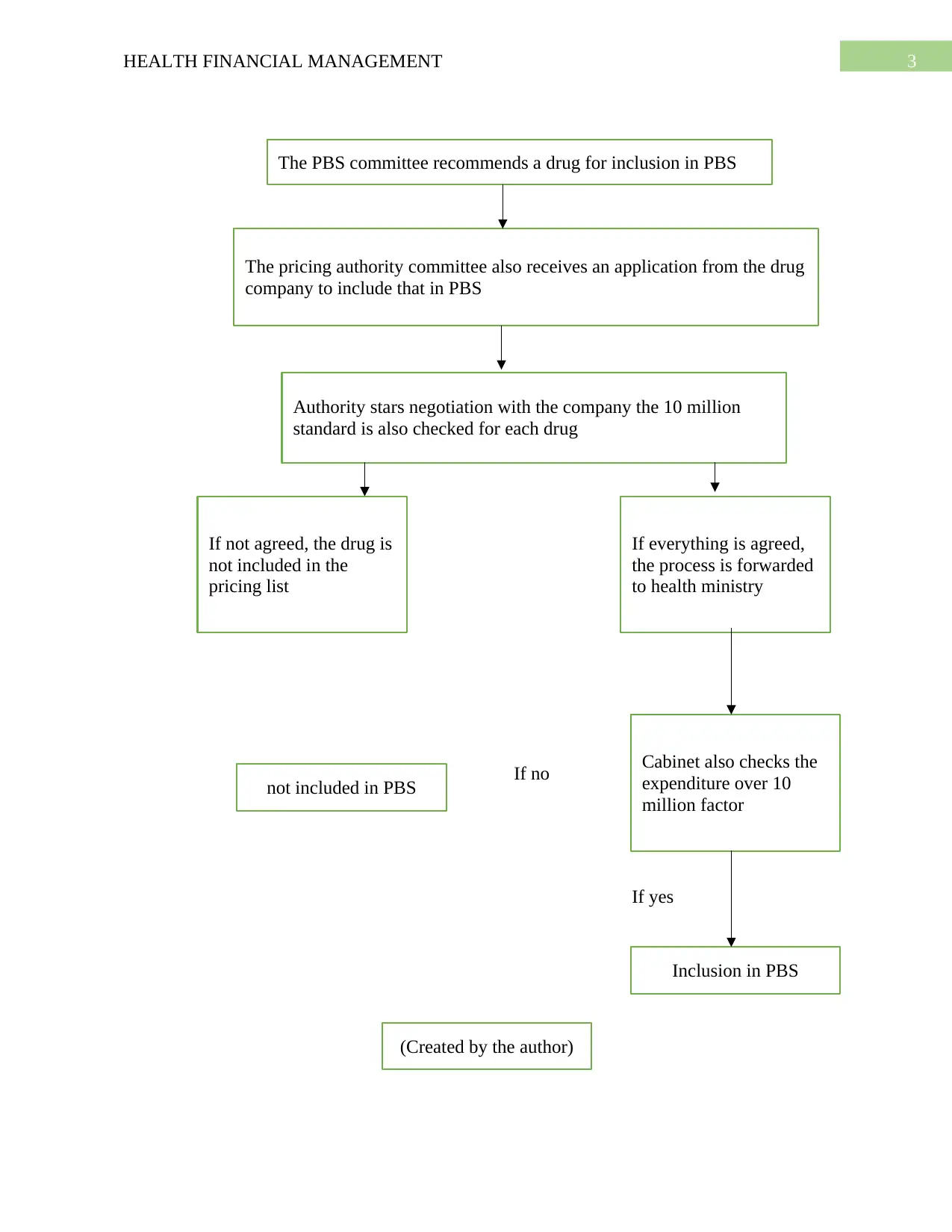
3HEALTH FINANCIAL MANAGEMENT
The PBS committee recommends a drug for inclusion in PBS
The pricing authority committee also receives an application from the drug
company to include that in PBS
Authority stars negotiation with the company the 10 million
standard is also checked for each drug
If everything is agreed,
the process is forwarded
to health ministry
If not agreed, the drug is
not included in the
pricing list
Cabinet also checks the
expenditure over 10
million factor
Inclusion in PBS
If yes
If no
not included in PBS
(Created by the author)
The PBS committee recommends a drug for inclusion in PBS
The pricing authority committee also receives an application from the drug
company to include that in PBS
Authority stars negotiation with the company the 10 million
standard is also checked for each drug
If everything is agreed,
the process is forwarded
to health ministry
If not agreed, the drug is
not included in the
pricing list
Cabinet also checks the
expenditure over 10
million factor
Inclusion in PBS
If yes
If no
not included in PBS
(Created by the author)
Paraphrase This Document
Need a fresh take? Get an instant paraphrase of this document with our AI Paraphraser
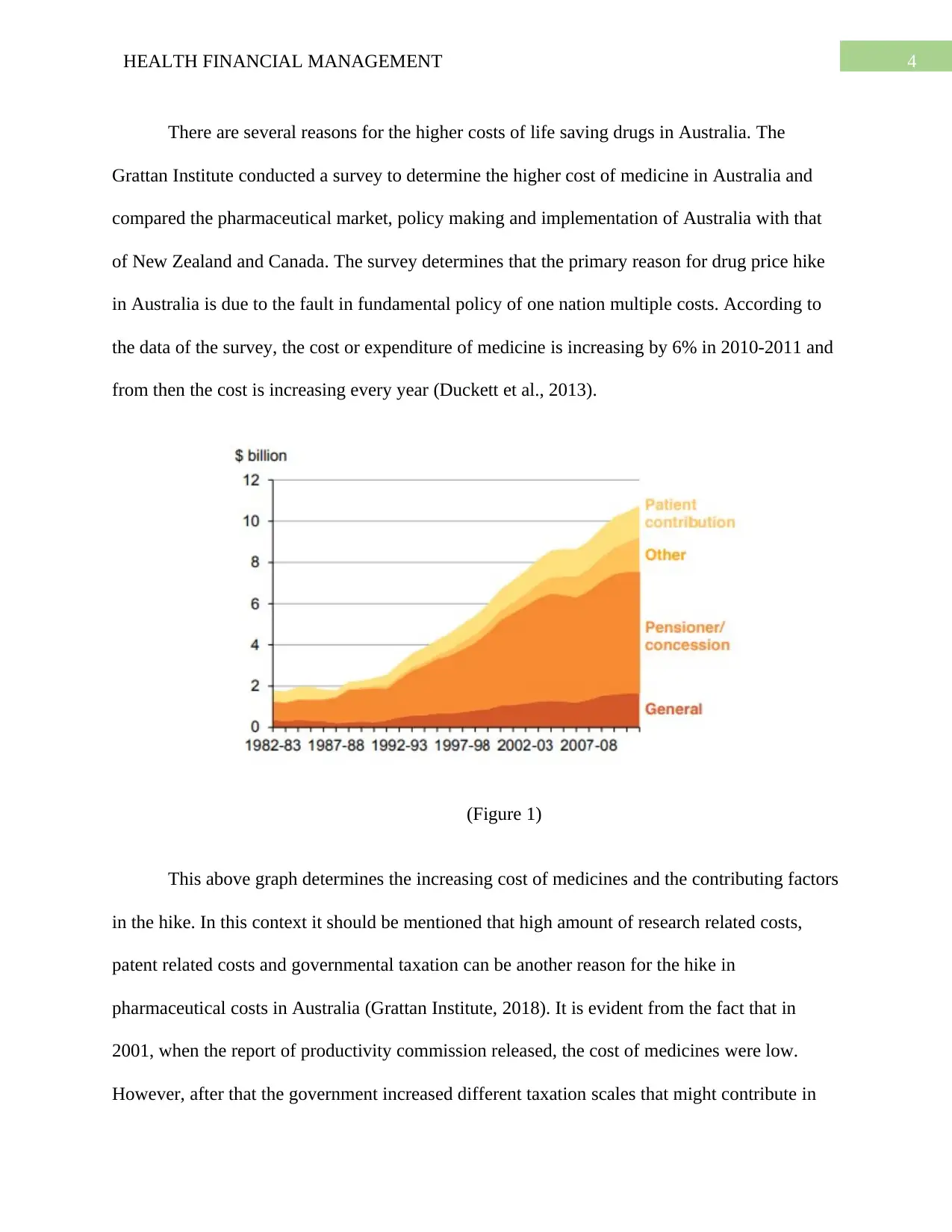
4HEALTH FINANCIAL MANAGEMENT
There are several reasons for the higher costs of life saving drugs in Australia. The
Grattan Institute conducted a survey to determine the higher cost of medicine in Australia and
compared the pharmaceutical market, policy making and implementation of Australia with that
of New Zealand and Canada. The survey determines that the primary reason for drug price hike
in Australia is due to the fault in fundamental policy of one nation multiple costs. According to
the data of the survey, the cost or expenditure of medicine is increasing by 6% in 2010-2011 and
from then the cost is increasing every year (Duckett et al., 2013).
(Figure 1)
This above graph determines the increasing cost of medicines and the contributing factors
in the hike. In this context it should be mentioned that high amount of research related costs,
patent related costs and governmental taxation can be another reason for the hike in
pharmaceutical costs in Australia (Grattan Institute, 2018). It is evident from the fact that in
2001, when the report of productivity commission released, the cost of medicines were low.
However, after that the government increased different taxation scales that might contribute in
There are several reasons for the higher costs of life saving drugs in Australia. The
Grattan Institute conducted a survey to determine the higher cost of medicine in Australia and
compared the pharmaceutical market, policy making and implementation of Australia with that
of New Zealand and Canada. The survey determines that the primary reason for drug price hike
in Australia is due to the fault in fundamental policy of one nation multiple costs. According to
the data of the survey, the cost or expenditure of medicine is increasing by 6% in 2010-2011 and
from then the cost is increasing every year (Duckett et al., 2013).
(Figure 1)
This above graph determines the increasing cost of medicines and the contributing factors
in the hike. In this context it should be mentioned that high amount of research related costs,
patent related costs and governmental taxation can be another reason for the hike in
pharmaceutical costs in Australia (Grattan Institute, 2018). It is evident from the fact that in
2001, when the report of productivity commission released, the cost of medicines were low.
However, after that the government increased different taxation scales that might contribute in
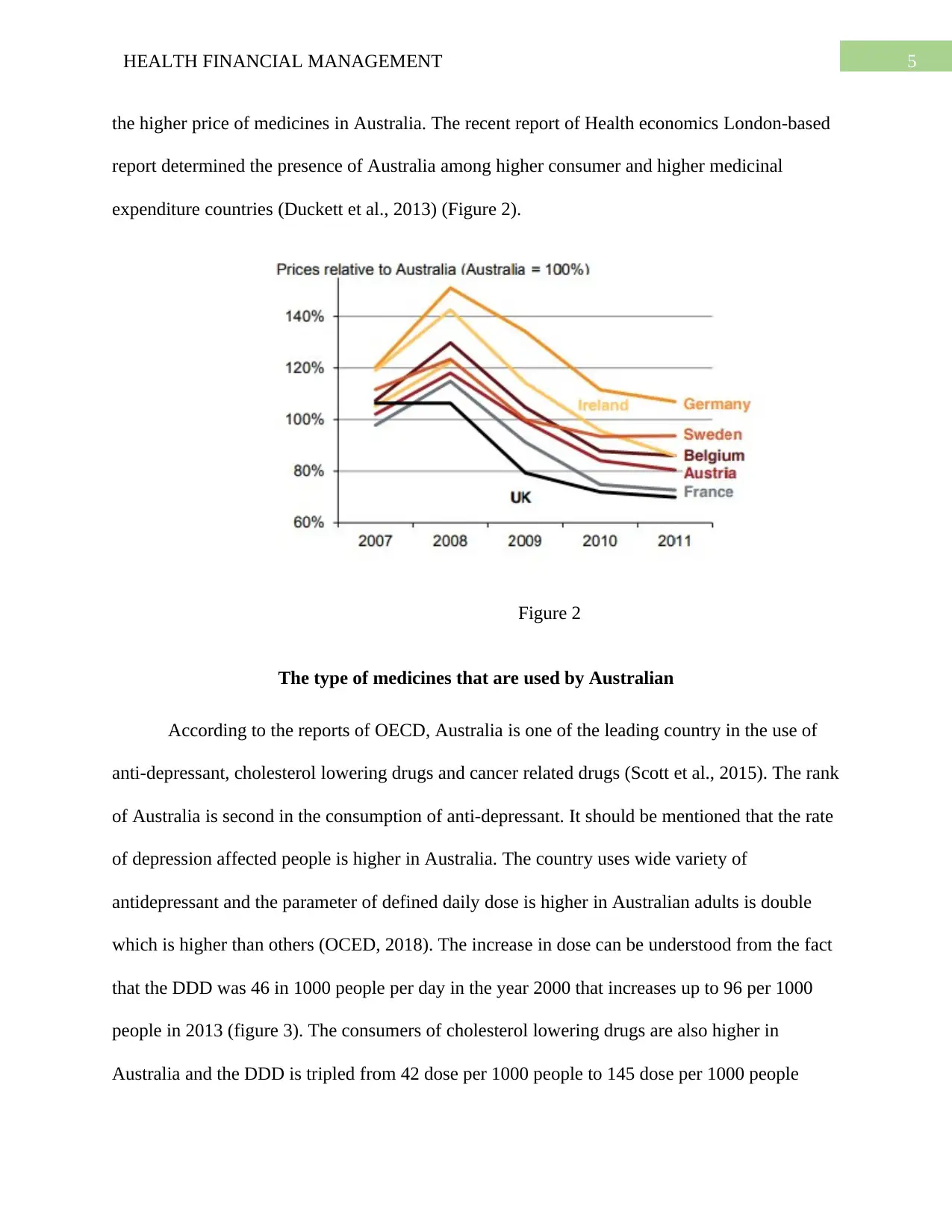
5HEALTH FINANCIAL MANAGEMENT
the higher price of medicines in Australia. The recent report of Health economics London-based
report determined the presence of Australia among higher consumer and higher medicinal
expenditure countries (Duckett et al., 2013) (Figure 2).
Figure 2
The type of medicines that are used by Australian
According to the reports of OECD, Australia is one of the leading country in the use of
anti-depressant, cholesterol lowering drugs and cancer related drugs (Scott et al., 2015). The rank
of Australia is second in the consumption of anti-depressant. It should be mentioned that the rate
of depression affected people is higher in Australia. The country uses wide variety of
antidepressant and the parameter of defined daily dose is higher in Australian adults is double
which is higher than others (OCED, 2018). The increase in dose can be understood from the fact
that the DDD was 46 in 1000 people per day in the year 2000 that increases up to 96 per 1000
people in 2013 (figure 3). The consumers of cholesterol lowering drugs are also higher in
Australia and the DDD is tripled from 42 dose per 1000 people to 145 dose per 1000 people
the higher price of medicines in Australia. The recent report of Health economics London-based
report determined the presence of Australia among higher consumer and higher medicinal
expenditure countries (Duckett et al., 2013) (Figure 2).
Figure 2
The type of medicines that are used by Australian
According to the reports of OECD, Australia is one of the leading country in the use of
anti-depressant, cholesterol lowering drugs and cancer related drugs (Scott et al., 2015). The rank
of Australia is second in the consumption of anti-depressant. It should be mentioned that the rate
of depression affected people is higher in Australia. The country uses wide variety of
antidepressant and the parameter of defined daily dose is higher in Australian adults is double
which is higher than others (OCED, 2018). The increase in dose can be understood from the fact
that the DDD was 46 in 1000 people per day in the year 2000 that increases up to 96 per 1000
people in 2013 (figure 3). The consumers of cholesterol lowering drugs are also higher in
Australia and the DDD is tripled from 42 dose per 1000 people to 145 dose per 1000 people
⊘ This is a preview!⊘
Do you want full access?
Subscribe today to unlock all pages.

Trusted by 1+ million students worldwide
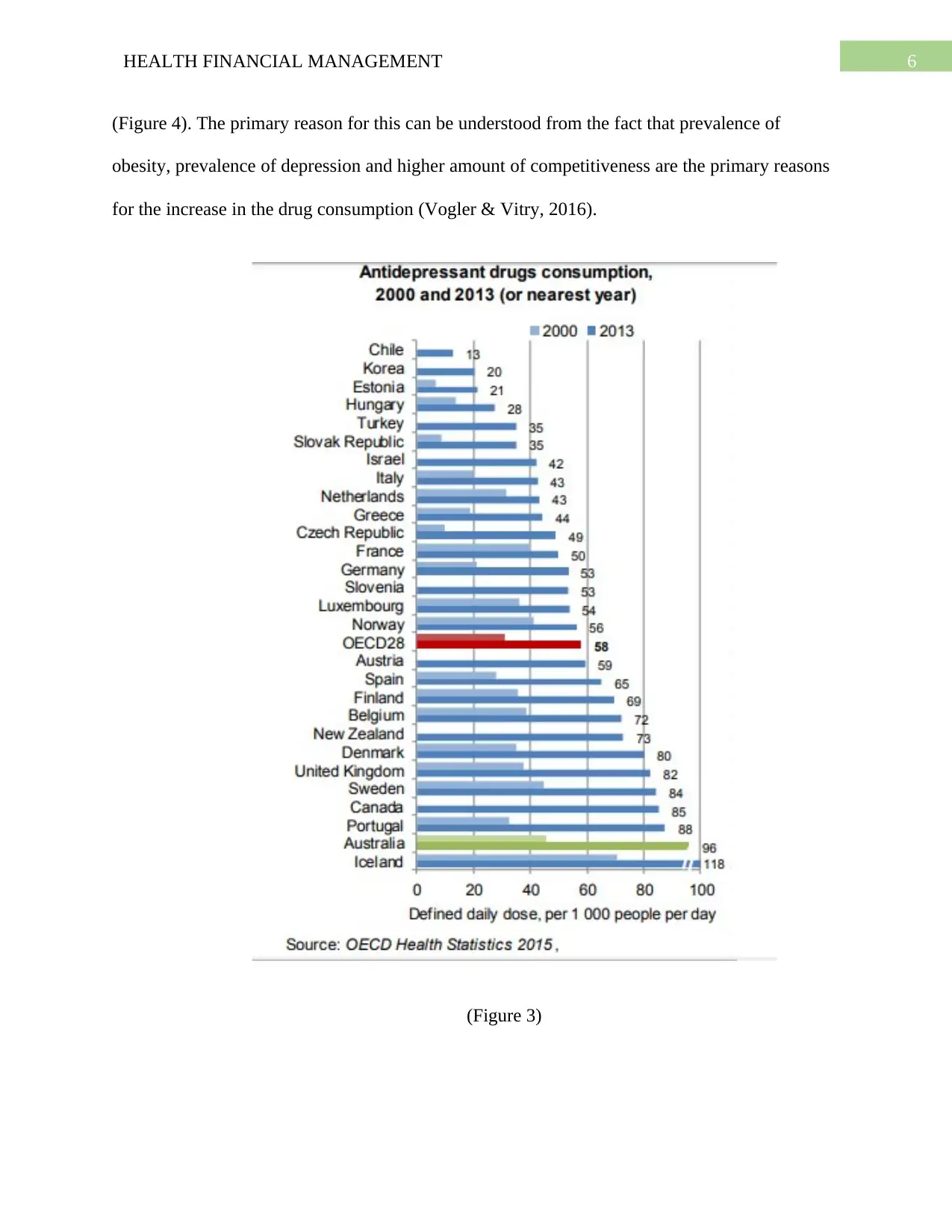
6HEALTH FINANCIAL MANAGEMENT
(Figure 4). The primary reason for this can be understood from the fact that prevalence of
obesity, prevalence of depression and higher amount of competitiveness are the primary reasons
for the increase in the drug consumption (Vogler & Vitry, 2016).
(Figure 3)
(Figure 4). The primary reason for this can be understood from the fact that prevalence of
obesity, prevalence of depression and higher amount of competitiveness are the primary reasons
for the increase in the drug consumption (Vogler & Vitry, 2016).
(Figure 3)
Paraphrase This Document
Need a fresh take? Get an instant paraphrase of this document with our AI Paraphraser
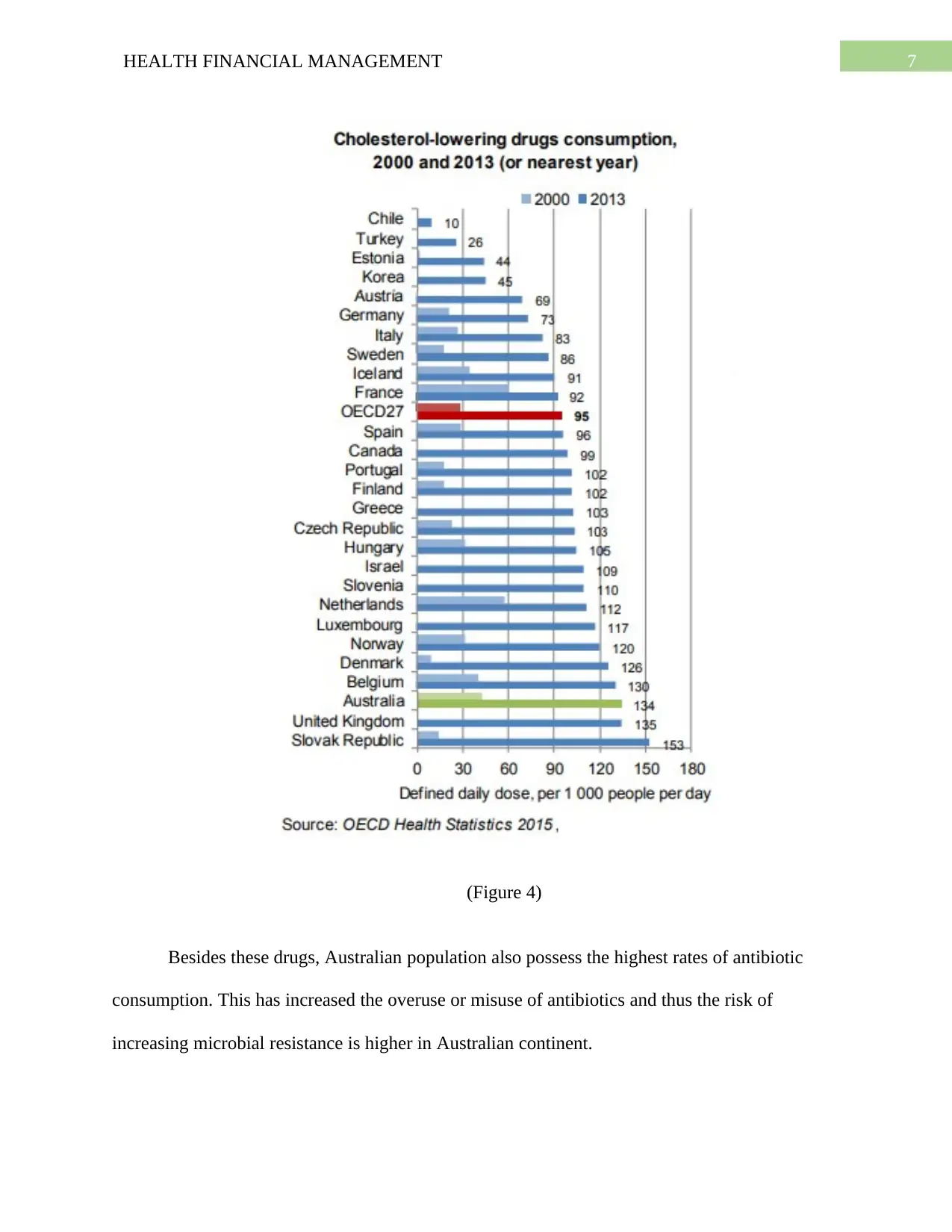
7HEALTH FINANCIAL MANAGEMENT
(Figure 4)
Besides these drugs, Australian population also possess the highest rates of antibiotic
consumption. This has increased the overuse or misuse of antibiotics and thus the risk of
increasing microbial resistance is higher in Australian continent.
(Figure 4)
Besides these drugs, Australian population also possess the highest rates of antibiotic
consumption. This has increased the overuse or misuse of antibiotics and thus the risk of
increasing microbial resistance is higher in Australian continent.
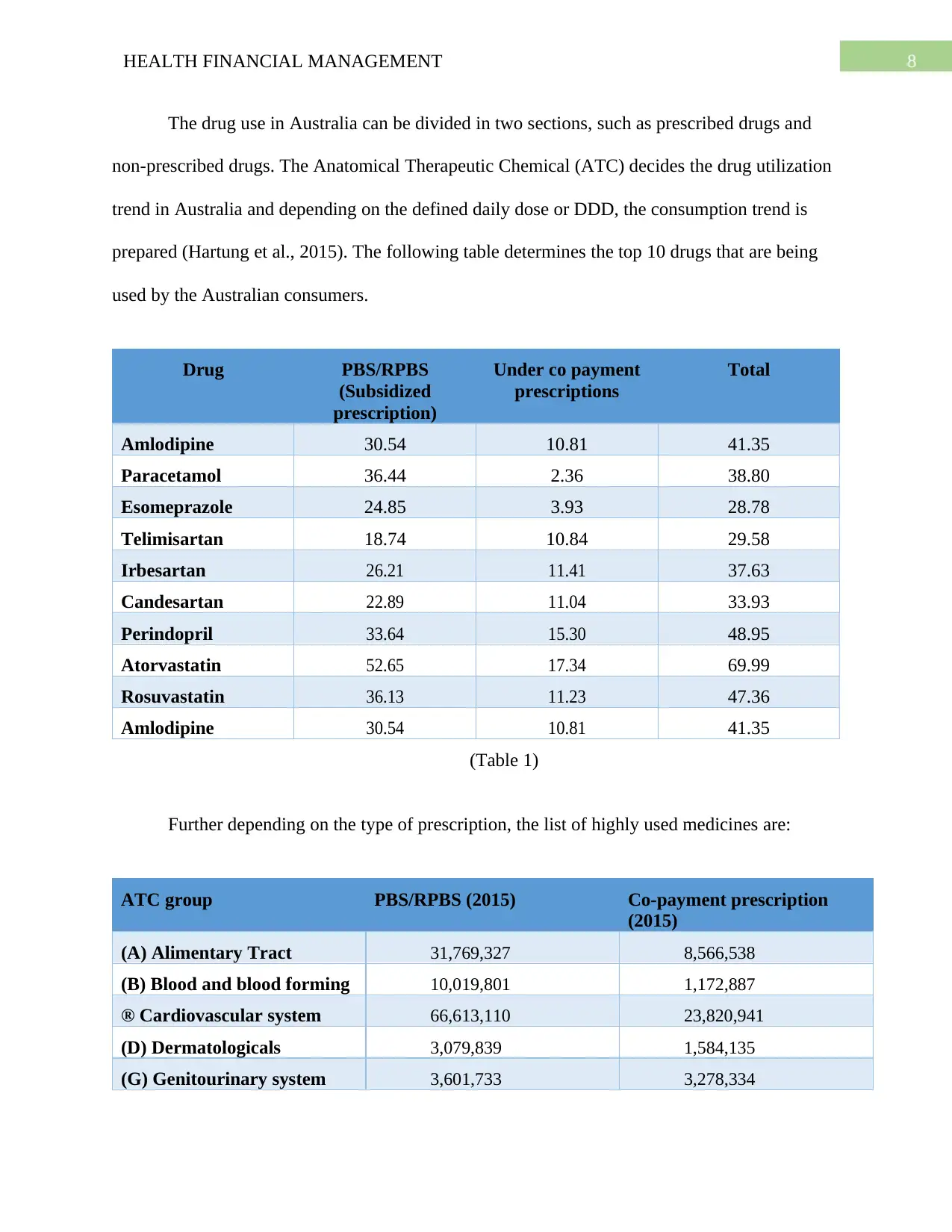
8HEALTH FINANCIAL MANAGEMENT
The drug use in Australia can be divided in two sections, such as prescribed drugs and
non-prescribed drugs. The Anatomical Therapeutic Chemical (ATC) decides the drug utilization
trend in Australia and depending on the defined daily dose or DDD, the consumption trend is
prepared (Hartung et al., 2015). The following table determines the top 10 drugs that are being
used by the Australian consumers.
Drug PBS/RPBS
(Subsidized
prescription)
Under co payment
prescriptions
Total
Amlodipine 30.54 10.81 41.35
Paracetamol 36.44 2.36 38.80
Esomeprazole 24.85 3.93 28.78
Telimisartan 18.74 10.84 29.58
Irbesartan 26.21 11.41 37.63
Candesartan 22.89 11.04 33.93
Perindopril 33.64 15.30 48.95
Atorvastatin 52.65 17.34 69.99
Rosuvastatin 36.13 11.23 47.36
Amlodipine 30.54 10.81 41.35
(Table 1)
Further depending on the type of prescription, the list of highly used medicines are:
ATC group PBS/RPBS (2015) Co-payment prescription
(2015)
(A) Alimentary Tract 31,769,327 8,566,538
(B) Blood and blood forming 10,019,801 1,172,887
® Cardiovascular system 66,613,110 23,820,941
(D) Dermatologicals 3,079,839 1,584,135
(G) Genitourinary system 3,601,733 3,278,334
The drug use in Australia can be divided in two sections, such as prescribed drugs and
non-prescribed drugs. The Anatomical Therapeutic Chemical (ATC) decides the drug utilization
trend in Australia and depending on the defined daily dose or DDD, the consumption trend is
prepared (Hartung et al., 2015). The following table determines the top 10 drugs that are being
used by the Australian consumers.
Drug PBS/RPBS
(Subsidized
prescription)
Under co payment
prescriptions
Total
Amlodipine 30.54 10.81 41.35
Paracetamol 36.44 2.36 38.80
Esomeprazole 24.85 3.93 28.78
Telimisartan 18.74 10.84 29.58
Irbesartan 26.21 11.41 37.63
Candesartan 22.89 11.04 33.93
Perindopril 33.64 15.30 48.95
Atorvastatin 52.65 17.34 69.99
Rosuvastatin 36.13 11.23 47.36
Amlodipine 30.54 10.81 41.35
(Table 1)
Further depending on the type of prescription, the list of highly used medicines are:
ATC group PBS/RPBS (2015) Co-payment prescription
(2015)
(A) Alimentary Tract 31,769,327 8,566,538
(B) Blood and blood forming 10,019,801 1,172,887
® Cardiovascular system 66,613,110 23,820,941
(D) Dermatologicals 3,079,839 1,584,135
(G) Genitourinary system 3,601,733 3,278,334
⊘ This is a preview!⊘
Do you want full access?
Subscribe today to unlock all pages.

Trusted by 1+ million students worldwide
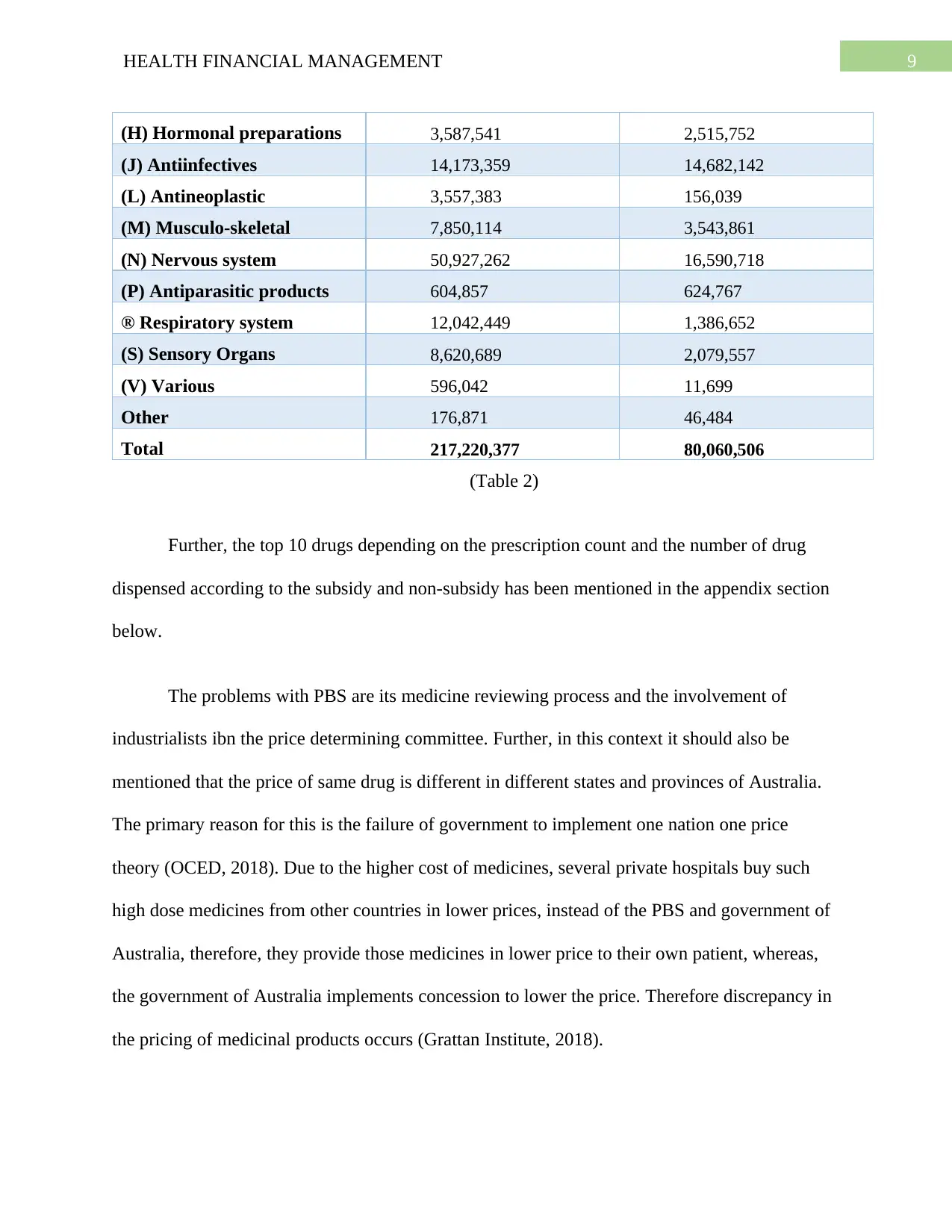
9HEALTH FINANCIAL MANAGEMENT
(H) Hormonal preparations 3,587,541 2,515,752
(J) Antiinfectives 14,173,359 14,682,142
(L) Antineoplastic 3,557,383 156,039
(M) Musculo-skeletal 7,850,114 3,543,861
(N) Nervous system 50,927,262 16,590,718
(P) Antiparasitic products 604,857 624,767
® Respiratory system 12,042,449 1,386,652
(S) Sensory Organs 8,620,689 2,079,557
(V) Various 596,042 11,699
Other 176,871 46,484
Total 217,220,377 80,060,506
(Table 2)
Further, the top 10 drugs depending on the prescription count and the number of drug
dispensed according to the subsidy and non-subsidy has been mentioned in the appendix section
below.
The problems with PBS are its medicine reviewing process and the involvement of
industrialists ibn the price determining committee. Further, in this context it should also be
mentioned that the price of same drug is different in different states and provinces of Australia.
The primary reason for this is the failure of government to implement one nation one price
theory (OCED, 2018). Due to the higher cost of medicines, several private hospitals buy such
high dose medicines from other countries in lower prices, instead of the PBS and government of
Australia, therefore, they provide those medicines in lower price to their own patient, whereas,
the government of Australia implements concession to lower the price. Therefore discrepancy in
the pricing of medicinal products occurs (Grattan Institute, 2018).
(H) Hormonal preparations 3,587,541 2,515,752
(J) Antiinfectives 14,173,359 14,682,142
(L) Antineoplastic 3,557,383 156,039
(M) Musculo-skeletal 7,850,114 3,543,861
(N) Nervous system 50,927,262 16,590,718
(P) Antiparasitic products 604,857 624,767
® Respiratory system 12,042,449 1,386,652
(S) Sensory Organs 8,620,689 2,079,557
(V) Various 596,042 11,699
Other 176,871 46,484
Total 217,220,377 80,060,506
(Table 2)
Further, the top 10 drugs depending on the prescription count and the number of drug
dispensed according to the subsidy and non-subsidy has been mentioned in the appendix section
below.
The problems with PBS are its medicine reviewing process and the involvement of
industrialists ibn the price determining committee. Further, in this context it should also be
mentioned that the price of same drug is different in different states and provinces of Australia.
The primary reason for this is the failure of government to implement one nation one price
theory (OCED, 2018). Due to the higher cost of medicines, several private hospitals buy such
high dose medicines from other countries in lower prices, instead of the PBS and government of
Australia, therefore, they provide those medicines in lower price to their own patient, whereas,
the government of Australia implements concession to lower the price. Therefore discrepancy in
the pricing of medicinal products occurs (Grattan Institute, 2018).
Paraphrase This Document
Need a fresh take? Get an instant paraphrase of this document with our AI Paraphraser
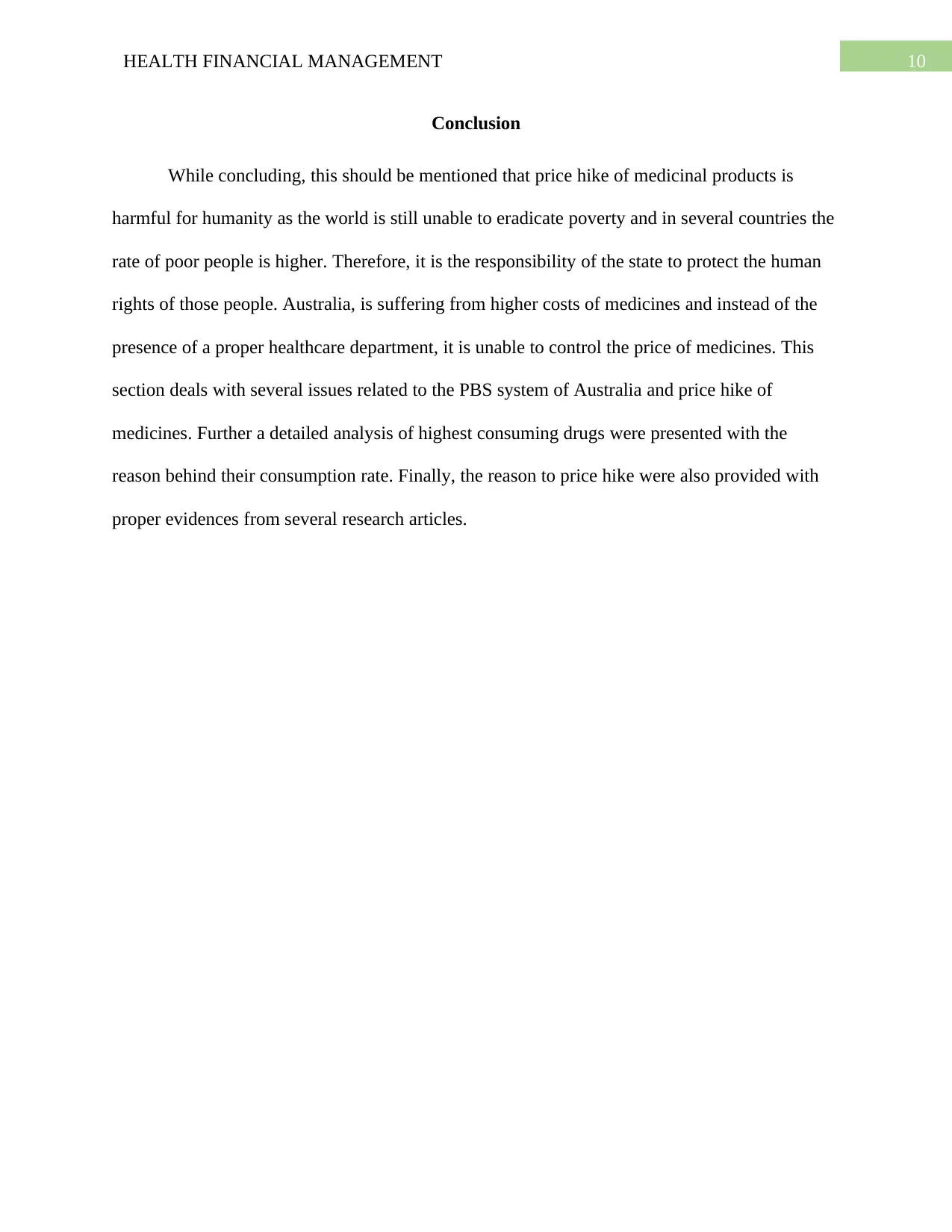
10HEALTH FINANCIAL MANAGEMENT
Conclusion
While concluding, this should be mentioned that price hike of medicinal products is
harmful for humanity as the world is still unable to eradicate poverty and in several countries the
rate of poor people is higher. Therefore, it is the responsibility of the state to protect the human
rights of those people. Australia, is suffering from higher costs of medicines and instead of the
presence of a proper healthcare department, it is unable to control the price of medicines. This
section deals with several issues related to the PBS system of Australia and price hike of
medicines. Further a detailed analysis of highest consuming drugs were presented with the
reason behind their consumption rate. Finally, the reason to price hike were also provided with
proper evidences from several research articles.
Conclusion
While concluding, this should be mentioned that price hike of medicinal products is
harmful for humanity as the world is still unable to eradicate poverty and in several countries the
rate of poor people is higher. Therefore, it is the responsibility of the state to protect the human
rights of those people. Australia, is suffering from higher costs of medicines and instead of the
presence of a proper healthcare department, it is unable to control the price of medicines. This
section deals with several issues related to the PBS system of Australia and price hike of
medicines. Further a detailed analysis of highest consuming drugs were presented with the
reason behind their consumption rate. Finally, the reason to price hike were also provided with
proper evidences from several research articles.
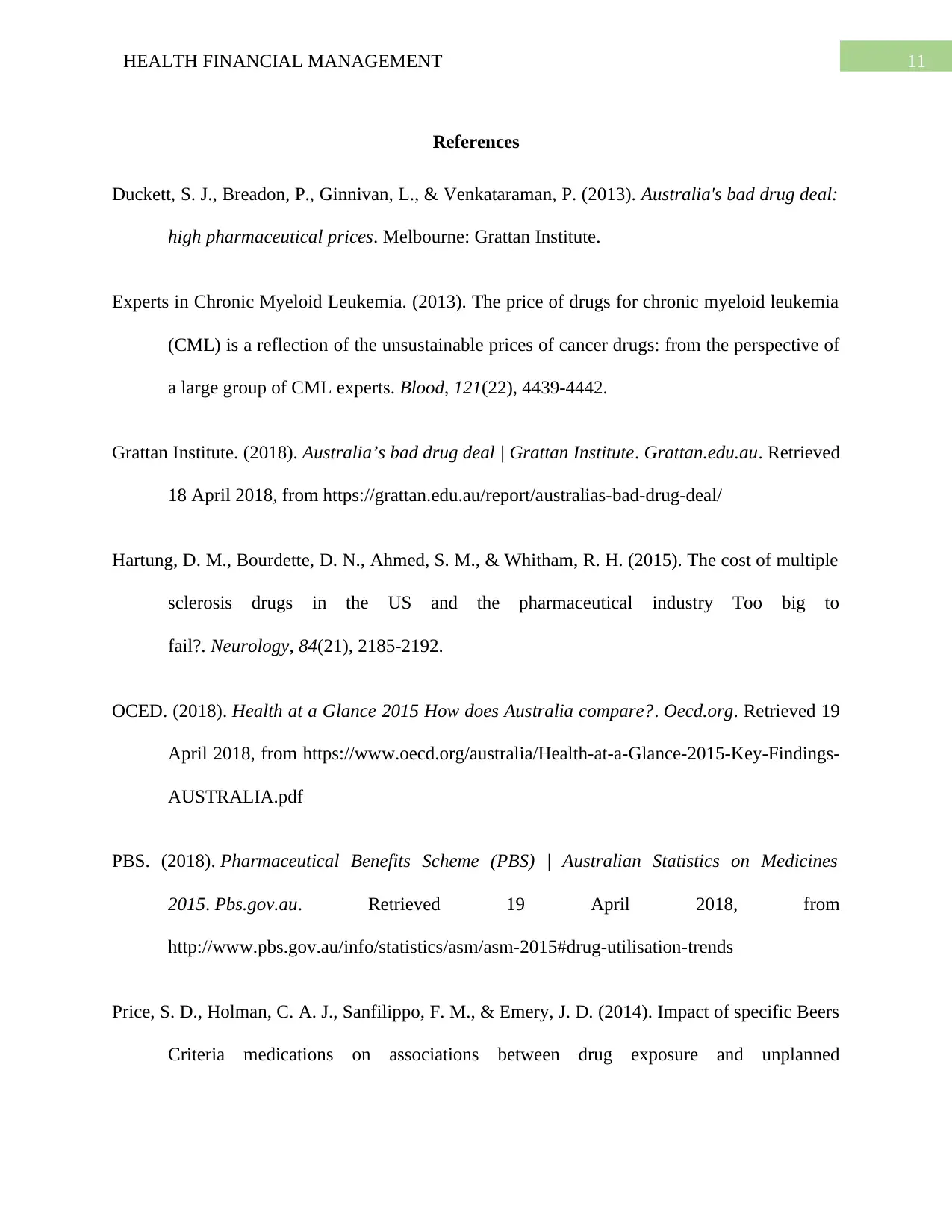
11HEALTH FINANCIAL MANAGEMENT
References
Duckett, S. J., Breadon, P., Ginnivan, L., & Venkataraman, P. (2013). Australia's bad drug deal:
high pharmaceutical prices. Melbourne: Grattan Institute.
Experts in Chronic Myeloid Leukemia. (2013). The price of drugs for chronic myeloid leukemia
(CML) is a reflection of the unsustainable prices of cancer drugs: from the perspective of
a large group of CML experts. Blood, 121(22), 4439-4442.
Grattan Institute. (2018). Australia’s bad drug deal | Grattan Institute. Grattan.edu.au. Retrieved
18 April 2018, from https://grattan.edu.au/report/australias-bad-drug-deal/
Hartung, D. M., Bourdette, D. N., Ahmed, S. M., & Whitham, R. H. (2015). The cost of multiple
sclerosis drugs in the US and the pharmaceutical industry Too big to
fail?. Neurology, 84(21), 2185-2192.
OCED. (2018). Health at a Glance 2015 How does Australia compare?. Oecd.org. Retrieved 19
April 2018, from https://www.oecd.org/australia/Health-at-a-Glance-2015-Key-Findings-
AUSTRALIA.pdf
PBS. (2018). Pharmaceutical Benefits Scheme (PBS) | Australian Statistics on Medicines
2015. Pbs.gov.au. Retrieved 19 April 2018, from
http://www.pbs.gov.au/info/statistics/asm/asm-2015#drug-utilisation-trends
Price, S. D., Holman, C. A. J., Sanfilippo, F. M., & Emery, J. D. (2014). Impact of specific Beers
Criteria medications on associations between drug exposure and unplanned
References
Duckett, S. J., Breadon, P., Ginnivan, L., & Venkataraman, P. (2013). Australia's bad drug deal:
high pharmaceutical prices. Melbourne: Grattan Institute.
Experts in Chronic Myeloid Leukemia. (2013). The price of drugs for chronic myeloid leukemia
(CML) is a reflection of the unsustainable prices of cancer drugs: from the perspective of
a large group of CML experts. Blood, 121(22), 4439-4442.
Grattan Institute. (2018). Australia’s bad drug deal | Grattan Institute. Grattan.edu.au. Retrieved
18 April 2018, from https://grattan.edu.au/report/australias-bad-drug-deal/
Hartung, D. M., Bourdette, D. N., Ahmed, S. M., & Whitham, R. H. (2015). The cost of multiple
sclerosis drugs in the US and the pharmaceutical industry Too big to
fail?. Neurology, 84(21), 2185-2192.
OCED. (2018). Health at a Glance 2015 How does Australia compare?. Oecd.org. Retrieved 19
April 2018, from https://www.oecd.org/australia/Health-at-a-Glance-2015-Key-Findings-
AUSTRALIA.pdf
PBS. (2018). Pharmaceutical Benefits Scheme (PBS) | Australian Statistics on Medicines
2015. Pbs.gov.au. Retrieved 19 April 2018, from
http://www.pbs.gov.au/info/statistics/asm/asm-2015#drug-utilisation-trends
Price, S. D., Holman, C. A. J., Sanfilippo, F. M., & Emery, J. D. (2014). Impact of specific Beers
Criteria medications on associations between drug exposure and unplanned
⊘ This is a preview!⊘
Do you want full access?
Subscribe today to unlock all pages.

Trusted by 1+ million students worldwide
1 out of 15
Related Documents
Your All-in-One AI-Powered Toolkit for Academic Success.
+13062052269
info@desklib.com
Available 24*7 on WhatsApp / Email
![[object Object]](/_next/static/media/star-bottom.7253800d.svg)
Unlock your academic potential
Copyright © 2020–2025 A2Z Services. All Rights Reserved. Developed and managed by ZUCOL.


